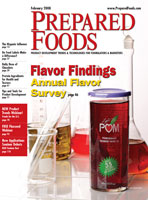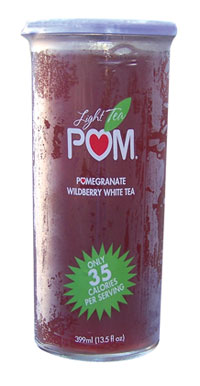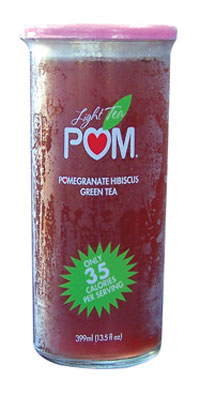

Pomegranate has seen a particular surge in recent years, as new products touting the flavor have capitalized on its positive health news. Most recently, the September 16American Journal of Cardiologyreported drinking one glass of pomegranate juice per day might improve blood flow to the heart. The randomized, double-blind, placebo-controlled trial found benefits for men and women, and it is the first such study to show that pomegranate juice may affect the progression of coronary heart disease, the leading cause of death in the U.S. and in most of the world.
Admittedly, this study and others like it have been based on consumption of pomegranate juice, which is rich in polyphenols and other naturally occurring antioxidants. Nevertheless, it can be presumed that products mentioning “pomegranate” aim to capitalize on the positive buzz surrounding the word. The flavor’s popularity has exploded in recent years, and another fruit flavor is following its lead.
In this year’s survey, açai topped the list of flavors expected to grow over the next three years. Similar to the pomegranate, the açai berry is a source of antioxidants, but the Amazonian fruit also boasts amino acids and essential fatty acids. Already popular in South America, açai is spreading northward rapidly, undoubtedly helped along by Oprah Winfrey’s proclamation of it as “superfood number one.” Winfrey’s website notes it has 10 times more antioxidants than red grapes and 10-30 times the anthocyanins of red wine, in addition to “a synergy of monounsaturated (healthy) fats, dietary fiber and phytosterols to help promote cardiovascular and digestive health.” Furthermore, a 2006 edition of theJournal of Agricultural and Food Chemistryreported extracts from açai berries triggered a self-destruct response in up to 86% of leukemia cells tested. With all of this positive press, it is easy to see why açai is quickly finding its way into sodas, juice blends, smoothies and other products.
In “Prepared Foods’ 2007 Flavor Survey” (conducted at the end of 2006), 54% of manufacturers said they were using fruit flavors or believed these would be in significant use in the next three years. In the 2008 edition of the survey, fruit flavors again scored high on the list of responses, as açai and pomegranate were at the top of flavors expected to increase in popularity over the next two years. For that matter, a healthy 7% of respondents believe "fruit" will increase in popularity during that time; in addition, after the aforementioned açai and pomegranate, a variety of other fruit flavors could be found peppered throughout the list, including mango (cited by 8% of respondents), citrus (5%), blueberry (5%), lime (5%) and mangosteen (4%).

Super Time
Grouping pomegranates with açai, goji berries and noni, Datamonitor’s Productscan database says these “superfruits” will go mainstream in 2008, as larger companies “get into the game.” While not mentioned as a flavor expected to grow the most over the next two years among those surveyed in the PF survey, the yumberry will make a breakthrough in 2008, Datamonitor believes. The subtropical fruit, originally from China, is being hailed around the world for its high antioxidant content and cranberry-like flavor. In the U.S., it can already be found in a beverage line from Frutzzo Natural Juice, which includes Yumberry Cherry and Yumberry Pomegranate blends. The company notes the yumberry is “unusually rich in Oligomeric Proanthocyanidins (OPCs),” which it claims are the most powerful class of free-radical-scavenging antioxidants, believed to support every metabolic system in the body. The OPCs even delve into the realm of the cosmeceutical, promising to slow the collapse of collagen--keeping skin firm, smooth and wrinkle-free.Mango seems to be another flavor of increasing attention among respondents to this year’s survey. As mentioned, 8% of respondents believe it will increase in popularity over the next three years, and it comprises a number of the flavor forecasts found in Joseph Baum & Michael Whiteman Co.’s “Top Dining Trends for 2008.” Michael Whiteman, co-owner of the group, notes interesting flavor possibilities in ice creams. “Oddball ice creams are showing up in unlikely combinations: tuna tartare with wasabi ice cream, cantaloupe sorbet with lavender-cured pork,foie grasterrine withfoie grasice cream, sweet corn ice cream with a grilled chocolate sandwich, andpaletas(Mexican ice pops) in such flavors as mango-and-chile and spicy cucumber-mango-jicama-orange.”
This development in Mexican foods should come as no surprise, considering nearly three quarters (72%) of respondents report their companies currently offer Mexican products or flavors. At the same time, well more than half of respondents (53%) offer Italian-focused products/flavors.
Asian flavors were likewise well-represented among respondents, as Chinese (40%), Japanese (27%) and Thai (26%) appeared in the top 10, with “other regional Asian” flavors garnering 19% of the vote.
Reflective of respondents’ confidence in these cuisines, they expect to increase development in Mexican, Thai and Japanese cuisines over the next two years. Mexican items, in fact, led the pack, with 75% of respondents predicting an increase in development, followed by 70% expecting an increase in development of fusion cuisine and 69% forecasting boosted efforts in Indian foods.
At the other end of the spectrum, a surprising number of respondents are predicting a decline in one currently vogue cuisine--Chinese. Of those surveyed, 11% anticipate a decrease in product development in Chinese foods over the next two years. French cuisine is likewise expected to see declines, as 10% of respondents indicated.
Italian foods, so widespread as to be considered virtually mainstream, are still expected to experience quite a degree of development. While perhaps not among the cuisines most expected to undergo increased development (only 49% say their company will increase efforts), another 48% say their development efforts in Italian foods will remain the same. This suggests that Italian cuisine will likely remain among the leading ethnic cuisines for some time to come.
Granted, these cuisines may have some way to go before they can be considered authentically ethnic, and “authentic” has been one of those key buzzwords floating around the industry for years. However, do developers regard it as a real trend?
A look at certain results fromPrepared Foods’ “2008 Flavoring Trends Survey” suggests they may not. Most respondents reported that the ethnic products developed at their company focus on reaching a broad audience. In fact, 57% of those surveyed are attempting to appeal to a “mainstream/Americanized” audience. More than a quarter (27%) are attempting to straddle the middle ground: they are working toward authenticity, while also making an effort to appeal to the mainstream consumer base. A surprisingly low 16% report a strong integrity to authenticity when it comes to their ethnic product development.

Bold and Beautiful
Flavor, of course, is vital to the success of any new food or beverage, but bolder is quickly becoming synonymous with better when it comes to flavors. Datamonitor’s Productscan database notes “bold flavors for aging taste buds” among its top 10 trends to watch for in 2008. It notes, “As we age, our senses of smell and taste can start to diminish, and this is being translated into consumers demanding hotter, spicier and bolder flavors.”“Look for bold flavors to pop up in brand-new areas,” it continues. “It’s already happening in Portugal, where Adagio Moments Yogurt Drink was launched in a spicy flavor earlier this year with a blend of chocolate chips, strawberries and chili peppers."
Bolder cheeses are likewise seeing sales gains, with a 6.3% increase in retail sales of bleu cheese, reports the Wisconsin Milk Marketing Board.
Asked to identify the most important areas where current natural flavors could use improvement, value and stability again finished at the top of the list. In the “2008 Flavoring Trends Survey,” 52% of respondents indicated they believe “good value for the money” is among the top three attributes where current natural products fall short. This is statistically unchanged from last year’s 50%, as the issue has taken the top spot for each of the last four years.
Holding the second spot again this year, as for the past four years, is flavor stability. The issue remains a concern to 40% of respondents, and this is down only slightly from the 45% citing it as an issue as far back as 2004. In fact, last year's survey found 91% of surveyed manufacturers believed flavor stability was the top flavor technology (overall) that has been and has the potential to be extremely useful in food and beverage formulations.
While value and stability have remained at the top, the number of those with these concerns has remained virtually unchanged. So which areas are seeing noticeably increased concern? In the area of synthetic flavorings, "true fidelity to foods they are to represent" registered a notable jump in the 2008 survey (10 percentage points), to 54% of respondents. A sizable portion of respondents noted the concern in the area of natural flavors as well. Within the last year, an additional 11% have grown worried about natural flavors' "true fidelity to the foods they are to represent." The 30% citing this issue in the previous year’s survey is well ahead of the 18-19% of the past two years and even of the 22% in 2004.
Over that same time frame, "organic certified or compatible" has emerged as an area for improvement for natural flavorings, more than doubling the 11% citing it as a major area of improvement in 2004. In the 2008 survey, 23% regard it as one of the top three attributes where current natural flavorings fall short, and "consistent quality" likewise hovers around the 25% mark, though its position has been statistically unchanged for the past three years.

Health Boost
It should be noted that only 21% believe the ability to add health benefits is one of the top three areas where natural flavorings fall short. “Natural” products have something of a halo of healthiness, likely shared with organic products, so that could explain why an issue as important as health is regarded as an issue by relatively few. Of course, unlike vitamins and nutraceuticals, the ability to improve health is not the primary purpose of a flavoring ingredient. This could be especially true when considering 44% of respondents say the “ability to add health benefits” is one of the top three areas where synthetic flavorings, in general, fall short. This health issue regarding synthetic flavorings skyrocketed 17 percentage points in the 2008 survey, as roughly a quarter of respondents believed it to be an issue in the previous year--a statistic that had remained relatively consistent for each of the three years before that.Manufacturers are beginning to understand a key point about consumers and their reaction to healthy foods: namely, good taste is an absolute must. Respondents were asked, “When considering healthful foods/beverages (compared to products that are not marketed as healthful), what expectations do you think consumers have with regard to flavor?” R&D and marketing professionals in the food industry overwhelmingly believe consumers demand at least the same flavor as non-healthful foods and beverages. Some 54% held that opinion, but another 18% say consumers are demanding healthy foods and beverages that are even more highly flavored than their non-healthy counterparts.
Furthermore, there is a growing opinion that flavor may play a role in satiety--or at least in overeating. The Smell and Taste Treatment and Research Foundation has discovered that patients who lost their sense of smell and taste were more likely to eat more. “Patients overate,” explains Alan Hirsch, director of the research, “in an attempt to regain some of the pleasure from eating that had been lost along with their sense of smell…The satiety center uses the odor molecules to operate the signals that indicate that the diner is satisfied.”
A similar sentiment can be found at the Yale-Griffin Prevention Research Center. David Katz, the center’s director and an associate professor of public health at Yale school of medicine, cites research that suggests that different basic food tastes stimulate different appetite centers in the brain. “Eat something salty, and one part of the brain responds,” he notes. “Sour foods stimulate another appetite center, and so on. Once stimulated, these centers direct us to keep eating until they feel ‘full.’ Roast turkey might satisfy the ‘savory’ taste center, but the aroma of pumpkin pie arouses the ‘sweet’ appetite center, which then clamors for dessert.” With additional flavors, more taste centers demand satisfaction, and the greater the variety of flavors, the more food is needed to feel that enough is enough--what Katz defines as the flavor point.
His theory suggests that narrowly focused flavors will trigger fewer of those appetite centers, ultimately meaning the consumer will need less food to feel full. For years, tasty treats have been regarded as a pariah responsible for the obesity epidemic. Could this be the dawn of flavor as a solution to this crisis?
Sidebar
POM WONDERFUL’S LIGHT POMEGRANATE WILDBERRY WHITE TEA’S INGREDIENT SYSTEM NOT ONLY INCLUDES INGREDIENTS SUCH AS WHITE PEONY TEA, POMEGRANATE AND BLACKBERRY JUICE, AND A PATENT-PENDING POMEGRANATE EXTRACT, BUT A “DASH” OF NATURAL FLAVORS, AS WELL. THE COMBINATION PROVIDES A DESIRABLE FLAVOR NOT ONLY DISTINCT FROM PRODUCTS NOW ON THE MARKET, BUT LIKELY IRREPRODUCIBLE BY “ME, TOO” EFFORTS OF OTHERS IN THE FUTURE. POPULAR PRODUCTS OFTEN PROMPT IMITATORS, BUT DUPLICATING FLAVOR PROFILES IS DIFFICULT, IF NOT IMPOSSIBLE.ADDED NATURAL AND/OR SYNTHETIC FLAVORS ARE INTERTWINED WITH A FORMULA’S MAJOR COMPONENTS (E.G., JUICE, FLOUR OR MEAT) THAT PROVIDE THEIR OWN FLAVOR. NATURAL FLAVORING ADDITIVES ARE OFTEN PRODUCED BY ISOLATION FROM FOODS OR THE BYPRODUCTS OF FOOD PROCESSING THROUGH DISTILLATION, EXTRACTION, PRESSING, FILTRATION AND CHROMATOGRAPHY METHODS. BEFORE USE IN COMMERCIAL PRODUCTS, THEY MUST BE APPROVED FOR USE. RAY MATULKA, PH.D., OF FOOD SCIENCE CONSULTING FIRM BURDOCK GROUP, SAYS THAT FEMA HAS EVALUATED MORE THAN 2,000 CHEMICALLY IDENTIFIED FLAVOR INGREDIENTS FOR SAFETY.
COMPANIES HAVE LONG STRIVED TO DETERMINE THE SPECIFIC AROMATIC MOLECULES IN A NATURAL FLAVORING. TYPICAL STEPS IN ANALYSIS, WITH AN EXAMPLE OF AN ANALYTICAL TECHNIQUE, INCLUDE:
1. ISOLATION AND CONCENTRATION (E.G., BY HEADSPACE ANALYSIS, DISTILLATION).
2. SEPARATION (E.G., BY GAS CHROMATOGRAPHY).
3. IDENTIFICATION (E.G., BY MASS SPECTROMETRY, CHROMATOGRAPHIC RETENTION).
4. SENSORY CHARACTERISTICS (E.G., BY SENSORY PANELS).
SOMETIMES A FLAVOR IS DOMINATED BY ONE MOLECULE, SUCH AS VANILLIN (VANILLA) OR EUGENOL (CLOVES). HOWEVER, MORE OFTEN, A LARGE NUMBER OF VOLATILE COMPOUNDS DETERMINE A PRODUCT’S CHARACTERISTIC AROMA. COFFEERESEARCH.ORG REPORTS THAT WELL OVER 800 AROMATIC COMPOUNDS ARE FOUND IN COFFEE, ALTHOUGH ONLY A SMALL GROUP OF COMPOUNDS (OF BOTH HIGH AND VERY LOW ODOR THRESHOLDS) PRODUCE THE FAMILIAR COFFEE AROMA.
WIKIPEDIA DEFINES “ODOR DETECTION THRESHOLD” AS THE LOWEST CONCENTRATION OF A COMPOUND PERCEIVABLE BY THE HUMAN SENSE OF SMELL. ALTHOUGH AN ODOR’S THRESHOLD IS “DETERMINED IN PART BY ITS SHAPE, POLARITY, PARTIAL CHARGES AND MOLECULAR WEIGHT,” HAVING THIS INFORMATION DOES NOT MEAN ITS THRESHOLD CAN BE PREDICTED.
IT HAS BEEN ESTIMATED THAN ONLY SOME 40 MOLECULES OF A POWERFUL AROMA ARE NEEDED TO TRIGGER AN IDENTIFIABLE SENSATION. ONE MEATY-TYPE AROMA, BIS-(2-METHYL-3-FURYL) DISULPHIDE, IS DETECTABLE AT TWO PARTS PER 1014 PARTS OF WATER. NEARER THE OTHER EXTREME, 1010 PARTS OF ETHANOL ARE NEEDED TO BE DETECTED IN THAT SAME AMOUNT OF WATER.
THRESHOLD VALUES ARE OFTEN BASED ON A COMPOUND IN WATER. HOWEVER, AS ONE STUDY (PLOTTO, A., ET AL. 2004. FLAVOUR AND FRAGRANCE JOURNAL. 19:491) NOTES, FLAVORS INTERACT WITH CARBOHYDRATES, PROTEINS AND OTHER FOOD CONSTITUENTS. THAT RESEARCH SHOWS THAT THE THRESHOLD LEVEL OF ODOR COMPOUNDS IN AN ORANGE JUICE MATRIX INCREASED BY 15-TO-200-FOLD VS. THE LEVEL IN WATER.
STRUCTURALLY RELATED COMPOUNDS MAY HAVE SIMILAR AROMAS, BUT OFTEN THIS IS NOT THE CASE. SOME COMPOUNDS ARE STRUCTURALLY UNRELATED BUT SMELL SIMILAR. CYCLOOCTANE, WHICH IS AN 8-CARBON RING STRUCTURE, AND CAMPHOR, A BI-CYCLIC MOLECULE WITH A FUNCTIONAL GROUP CONTAINING OXYGEN, BOTH HAVE A CAMPHORIC ODOR. SOME COMPOUNDS ARE STRUCTURALLY SIMILAR BUT SMELL VERY DIFFERENT. FOR EXAMPLE, CHIRAL FLAVOR MOLECULES HAVE MIRROR IMAGES. OFTEN ONE ELICITS A STRONG ODOR, WHILE THE OTHER IS WEAK. HOWEVER, (S)-(+)-CARVONE IS THE AROMATIC INGREDIENT OF CARAWAY SEEDS, WHILE (R)-(–)-CARVONE SMELLS LIKE SPEARMINT. THE UNPREDICTABILITY OF SUCH COMPOUNDS MEANS FLAVOR RESEARCH WILL REMAIN AN ACTIVE FIELD FOR YEARS TO COME.
--CLAUDIA D. O’DONNELL, CHIEF EDITOR
